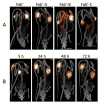Site specific discrete PEGylation of (124)I-labeled mCC49 Fab' fragments improves tumor MicroPET/CT imaging in mice
- PMID: 24175669
- PMCID: PMC4240220
- DOI: 10.1021/bc400375f
Site specific discrete PEGylation of (124)I-labeled mCC49 Fab' fragments improves tumor MicroPET/CT imaging in mice
Abstract
The tumor-associated glycoprotein-72 (TAG-72) antigen is highly overexpressed in various human adenocarcinomas and anti-TAG-72 monoclonal antibodies, and fragments are therefore useful as pharmaceutical targeting vectors. In this study, we investigated the effects of site-specific PEGylation with MW 2-4 kDa discrete, branched PEGylation reagents on mCC49 Fab' (MW 50 kDa) via in vitro TAG72 binding, and in vivo blood clearance kinetics, biodistribution, and mouse tumor microPET/CT imaging. mCC49Fab' (Fab'-NEM) was conjugated at a hinge region cysteine with maleimide-dPEG 12-(dPEG24COOH)3 acid (Mal-dPEG-A), maleimide-dPEG12-(dPEG12COOH)3 acid (Mal-dPEG-B), or maleimide-dPEG12-(m-dPEG24)3 (Mal-dPEG-C), and then radiolabeled with iodine-124 ((124)I) in vitro radioligand binding assays and in vivo studies used TAG-72 expressing LS174T human colon carcinoma cells and xenograft mouse tumors. Conjugation of mCC49Fab' with Mal-dPEG-A (Fab'-A) reduced the binding affinity of the non PEGylated Fab' by 30%; however, in vivo, Fab'-A significantly lengthened the blood retention vs Fab'-NEM (47.5 vs 28.1%/ID at 1 h, 25.1 vs 8.4%/ID at 5 h, p < 0.01), showed excellent tumor to background, better microPET/CT images due to higher tumor accumulation, and increased tumor concentration in excised tissues at 72 h by 130% (5.09 ± 0.83 vs 3.83 ± 1.50%ID/g, p < 0.05). Despite the strong similarity of the three PEGylation reagents, PEGylation with Mal-dPEG-B or -C reduced the in vitro binding affinity of Fab'-NEM by 70%, blood retention, microPET/CT imaging tumor signal intensity, and residual 72 h tumor concentration by 49% (3.83 ± 1.50 vs 1.97 ± 0.29%ID/g, p < 0.05) and 63% (3.83 ± 1.50 vs 1.42 ± 0.35%ID/g, p < 0.05), respectively. We conclude that remarkably subtle changes in the structure of the PEGylation reagent can create significantly altered biologic behavior. Further study is warranted of conjugates of the triple branched, negatively charged Mal-dPEG-A.
Conflict of interest statement
The authors declare the following competing financial interest(s): A.P., P.D., and R.B. are or were (R.B.) employees of Quanta Biodesign for this work.
Figures






Similar articles
-
Reagents for astatination of biomolecules. 5. Evaluation of hydrazone linkers in (211)At- and (125)I-labeled closo-decaborate(2-) conjugates of Fab' as a means of decreasing kidney retention.Bioconjug Chem. 2011 Jun 15;22(6):1089-102. doi: 10.1021/bc1005625. Epub 2011 May 5. Bioconjug Chem. 2011. PMID: 21513347 Free PMC article.
-
Anti-CEA antibody fragments labeled with [(18)F]AlF for PET imaging of CEA-expressing tumors.Bioconjug Chem. 2014 Feb 19;25(2):335-41. doi: 10.1021/bc4004926. Epub 2014 Jan 8. Bioconjug Chem. 2014. PMID: 24382090
-
Specific Conjugation of the Hinge Region for Homogeneous Preparation of Antibody Fragment-Drug Conjugate: A Case Study for Doxorubicin-PEG-anti-CD20 Fab' Synthesis.Bioconjug Chem. 2016 Jan 20;27(1):238-46. doi: 10.1021/acs.bioconjchem.5b00626. Epub 2016 Jan 4. Bioconjug Chem. 2016. PMID: 26700095
-
Radioiodinated anti–TAG-72 CC49 Fab’ antibody fragment.2008 Mar 10 [updated 2008 Apr 9]. In: Molecular Imaging and Contrast Agent Database (MICAD) [Internet]. Bethesda (MD): National Center for Biotechnology Information (US); 2004–2013. 2008 Mar 10 [updated 2008 Apr 9]. In: Molecular Imaging and Contrast Agent Database (MICAD) [Internet]. Bethesda (MD): National Center for Biotechnology Information (US); 2004–2013. PMID: 20641734 Free Books & Documents. Review.
-
Radioiodinated anti–TAG-72 CC49 (Fab’)2 antibody fragment.2007 Nov 5 [updated 2008 Jan 9]. In: Molecular Imaging and Contrast Agent Database (MICAD) [Internet]. Bethesda (MD): National Center for Biotechnology Information (US); 2004–2013. 2007 Nov 5 [updated 2008 Jan 9]. In: Molecular Imaging and Contrast Agent Database (MICAD) [Internet]. Bethesda (MD): National Center for Biotechnology Information (US); 2004–2013. PMID: 20641775 Free Books & Documents. Review.
Cited by
-
Site-Specifically Labeled Immunoconjugates for Molecular Imaging--Part 2: Peptide Tags and Unnatural Amino Acids.Mol Imaging Biol. 2016 Apr;18(2):153-65. doi: 10.1007/s11307-015-0920-y. Mol Imaging Biol. 2016. PMID: 26754791 Free PMC article. Review.
-
Improving external beam radiotherapy by combination with internal irradiation.Br J Radiol. 2015 Jul;88(1051):20150042. doi: 10.1259/bjr.20150042. Epub 2015 Mar 18. Br J Radiol. 2015. PMID: 25782328 Free PMC article. Review.
-
Research progress on the PEGylation of therapeutic proteins and peptides (TPPs).Front Pharmacol. 2024 Mar 8;15:1353626. doi: 10.3389/fphar.2024.1353626. eCollection 2024. Front Pharmacol. 2024. PMID: 38523641 Free PMC article. Review.
-
ImmunoPET: Concept, Design, and Applications.Chem Rev. 2020 Apr 22;120(8):3787-3851. doi: 10.1021/acs.chemrev.9b00738. Epub 2020 Mar 23. Chem Rev. 2020. PMID: 32202104 Free PMC article. Review.
-
Miniaturized Fab' imaging probe derived from a clinical antibody: Characterization and imaging in CRISPRi-attenuated mammary tumor models.iScience. 2024 May 24;27(8):110102. doi: 10.1016/j.isci.2024.110102. eCollection 2024 Aug 16. iScience. 2024. PMID: 39184438 Free PMC article.
References
-
- Johnson VG, Schlom J, Paterson AJ, Bennett J, Magnani JL, Colcher D. Analysis of a human tumor-associated glycoprotein (TAG-72) identified by monoclonal antibody B72.3. Cancer Res. 1986;46:850–857. - PubMed
-
- Sheer DG, Schlom J, Cooper HL. Purification and composition of the human tumor-associated glycoprotein (TAG-72) defined by monoclonal antibodies CC49 and B72.3. Cancer Res. 1988;48:6811–6818. - PubMed
-
- Loy TS, Nashelsky MB. Reactivity of B72.3 with adenocarcinomas. An immunohistochemical study of 476 cases. Cancer. 1993;72:2495–2498. - PubMed
-
- Povoski SP, Hatzaras IS, Mojzisik CM, Arnold MW, Hinkle GH, Hitchcock CL, Young DC, Martin EW., Jr Antigen-directed cancer surgery for primary colorectal cancer: 15-year survival analysis. Ann Surg Oncol. 2012;19:131–138. - PubMed
Publication types
MeSH terms
Substances
Grants and funding
LinkOut - more resources
Full Text Sources
Other Literature Sources
Medical
Research Materials

